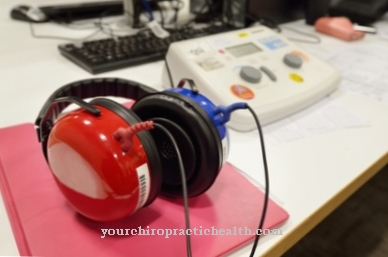The term Eye test refers to a whole series of different examinations of the eye and the ability to see or visual perception. With their help, it is determined whether the person in question needs an optical aid such as glasses or contact lenses. In some professions or before obtaining a driver's license, an eye test is required.
What is an eye test?

Under a Eye test Experts understand various tests and examinations that can be carried out in relation to human vision and perception.
In most cases it is primarily the visual acuity of the respective person that is determined. In principle, however, examinations of color vision, stereo vision or simultaneous viewing also fall under the general term "eye test".
Which values are specified in accordance with the standard and from when, for example, the use of an optical aid or medical treatment is necessary. Eye tests are carried out by an ophthalmologist or optician and are necessary, for example, if you are about to acquire a driver's license or if you want to work in a job that requires perfect eyesight.
Function, effect & goals
A Eye test In most cases this is carried out as part of a general eye examination by an ophthalmologist. Among other things, the patient's visual acuity is determined. This is done with the help of the so-called eye test table, on which there are letters of different sizes.
Each eye is examined one after the other. If it is difficult for the patient to see letters with one or both eyes, they have poor eyesight. The ophthalmologist will then prescribe appropriate glasses or contact lenses. If the patient is already in possession of such an optical aid, the eye test can be used to determine whether the respective visual strength of the glasses / contact lenses is still sufficient or whether they need to be adjusted.
In this case, an optician can also perform the eye test and then issue a new eye aid. The vision test is intended to ensure that possible ametropia can be recognized and compensated for. Regular eye examinations are therefore advisable, at the latest when the person concerned notices changes in their visual acuity or general perception.
Progressive and untreated visual defects may get worse over time. If a visual aid is prescribed at an early stage, this process can be slowed down. Last but not least, poor eyesight often also means a risk, for example when driving a vehicle. For this reason, an eye test must be completed before obtaining a driver's license.
Under certain circumstances, the driver's license can then be issued on the condition that appropriate visual aids are worn while driving. This is intended to minimize the risk of traffic accidents with property damage and personal injury.
Risks, dangers & notices
With a regular Eye test, in the course of which the visual acuity of the respective person is tested, it is a purely visual test. All the patient has to do is read letters and / or numbers from an eye test table and thus provide information on how pronounced the visual acuity of both eyes is.
For this reason, there are no risks or dangers involved in this investigation. This also applies if, in addition to visual acuity, visual tests are carried out to test spatial vision or the visual field. If further examinations regarding vision and perception are carried out and if there is a suspicion of an eye disease, the attending physician can, for example, give eye drops to dilate the pupils.
This is done so that he can examine the fundus more closely. In this case, hypersensitivity reactions can occur in rare cases. This examination must not be performed in patients with cataracts. After a dilated pupil, patients must still be aware that their vision is temporarily impaired and that they are therefore not allowed to drive a car, motorcycle or bicycle for a few hours.
In the case of a pure eye test with normal results, however, such examinations are not necessary. The eye test itself therefore does not involve any risks, but rather helps to significantly minimize possible dangers for the person concerned and other road users by eliminating visual impairment.
You can find your medication here
➔ Medicines for visual disturbances and eye complaintsTypical & common eye diseases
- Inflammation of the eyes
- Eye pain
- Conjunctivitis
- Double vision (diplopia)
- Photosensitivity
- Nearsightedness (myopia)
- Farsightedness (hyperopia)













.jpg)

.jpg)
.jpg)











.jpg)